Tales of legendary outlaws, daring heists, and cunning escapes have captivated audiences worldwide for decades. So much so that they have their own genre called “caper films.”
With that in mind, let’s follow in the footsteps of some of these lawless legends –– shaped by rebellion, desperation, or outright greed –– and delve into their early lives, criminal exploits, captures, and the truths lurking behind their actions.
Today’s Focus of Attention is reader-supported. We sometimes include products we think are useful for our readers. If you buy through links on this page, we may earn a small commission.
Billy the Kid
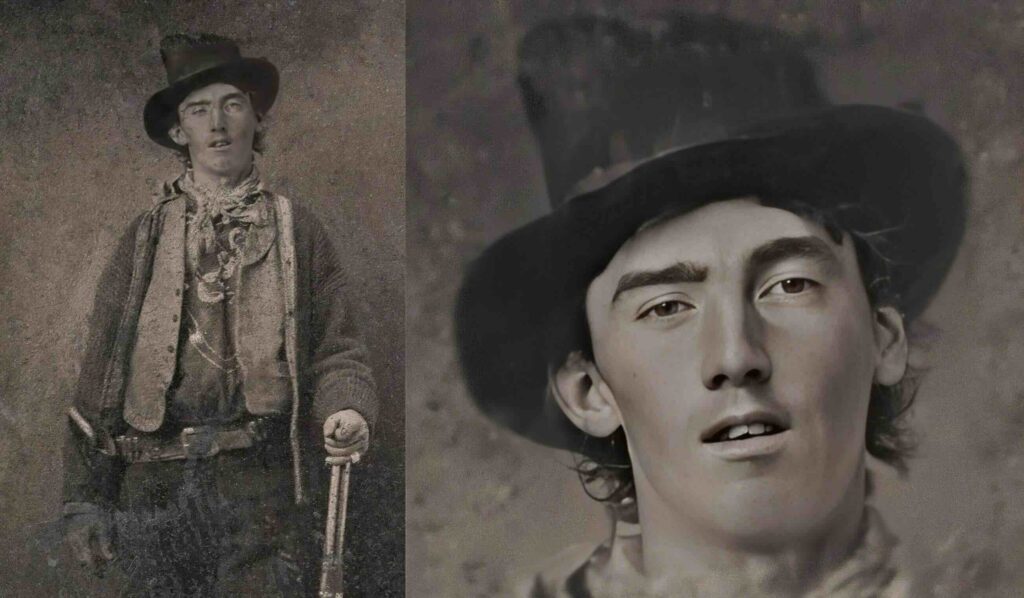
A gunslinger of the Wild West, Billy the Kid is best known for his involvement in the Lincoln County War in New Mexico.
Early Years
Born under the name of Henry McCarty on 23rd November 1859 in New York City, his hard life started at 7 when his father vanished.
This hardship led the family to relocate—from Indiana to Kansas and, finally, to New Mexico. There, his mother, Irish immigrant Catherine McCarthy, remarried William Antrim.
When Billy was 14, his mother passed away from tuberculosis, leaving him and his brother, Joseph, orphaned. Without maternal guidance, the young boys embarked on a trail of illicit deeds, escalating from stealing food and clothes to firearms, resulting in a time in prison.
The Nickname that Made Him Legendary
As a lawbreaker, Henry McCarty was known as “Kid Antrim.” Later on, he adopted another alias, “William H. Bonney,” but his most famous and remembered moniker was “Billy the Kid” due to a combination of his youthful looks and reputation as a juvenile delinquent.
The Lincoln County War: A Bloody Chapter in the Wild West
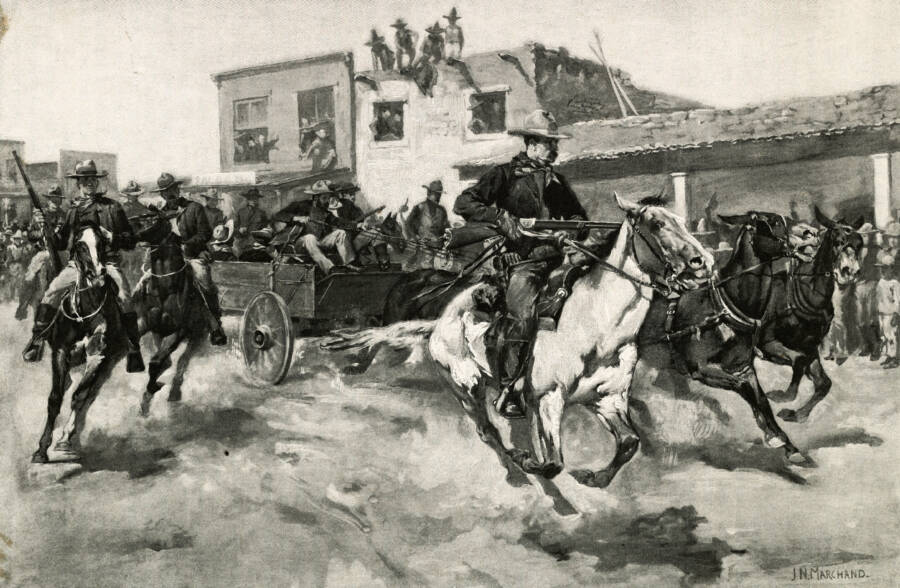
Given the vast open spaces of New Mexico, agriculture, livestock, mining, and commerce dominated the region’s economy. Contracts to deliver cattle to reservations, such as Bosque Redondo, were above all lucrative.
Prominent New Mexican families such as the Chavez, Otero, and Perea played significant roles in the trade network, establishing extensive commercial connections not only within the U.S. but also with European markets. These merchants would travel to New York, Philadelphia, and Baltimore to purchase goods, which they then sold in New Mexico.
But other groups in the territory carried weight, including the Murphy-Dolan. This influential faction, led by Irish immigrants Lawrence Murphy and James Dolan, wanted total control of the trade in the region.
In 1876, John Tunstall, an English businessman, and Alexander McSween moved to Lincoln County and opened a competing store against the established and corrupt Murphy-Dolans. Tunstall hired Billy the Kid as a ranch hand and protector. Tensions escalated when Tunstall was murdered by a gang affiliated with the Murphy-Dolans.
This event deeply affected Billy, who vowed to avenge Tunstall’s death.
The Kid joined a group called “The Regulators,” which targeted those responsible, including Sheriff Willian Brady, who was aligned with the Murphy-Dolans. The Regulators executed the sheriff, along with several others, leading to violent skirmishes and battles. Billy the Kid became infamous for his bold exploits. Legend has it that he killed 21 men, one for each year of his life.
It was not long before the territorial government took action to restore order.
Billy the Kid’s Capture and Daring Escape
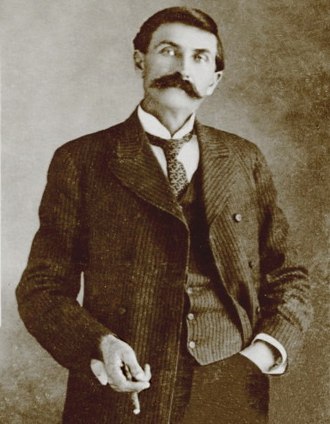
Commanding a group, Sheriff Pat Garrett chased and found Billy the Kid at Stinking Springs, a hideout near Fort Sumner. They surrounded the outlaws in the wee hours and stood by until dawn to surprise the gang.
As the first rays of sun appeared, shooting broke out. After a brief standoff, Billy the Kid and his band of rogues surrendered and were taken to Mesilla, New Mexico; the “Kid” was convicted and sentenced to hang for Sheriff William Brady’s murder. However, the prison bars couldn’t hold Billy for long, as he soon orchestrated a daring escape.
Billy was shackled and confined on the second floor of the courthouse. After using the privy, Deputy James Bell escorted him back to his cell. There, the felon tricked the officer into loosening his restraints, allowing him to seize the deputy’s gun and deliver a fatal gunshot. After that, Billy grabbed a double-barrel shotgun and killed a second deputy, Bob Olinger, who had rushed back from across the street when hearing the gunfire. Billy managed to remove his leg irons, mounted a stolen horse, and rode out of Lincoln. Eyewitnesses claimed that he boldly sang and yelled as he departed.
This audacious escape on 28th April 1881 embarrassed authorities and cemented Billy’s distinction as a fearless outlaw. But this was Billy’s last major act of defiance.
Billy the Kid Death
Sheriff Pat Garrett, determined to end this evil for good, investigated with precision those who knew Billy the Kid. On the night of 14th July 1881, the sheriff and his deputies entered the home of Pete Maxwell, Kid’s friend, hoping to catch the outlaw. The sheriff’s hunch was right. Later that same evening, Billy got into the house, looking for food. But unbeknownst to him, the veil of darkness had covered Pat Garrett in Maxwell’s bedroom.
Seeing the shadowy figure, he asked in Spanish, “Who is it?” Two deafening shots came out from Garrett’s .45 Colt, with one bullet striking Billy’s chest, killing him as quick as lightning. Billy the Kid was 21 years old.
Jesse James: The Old West’s Legendary Outlaw
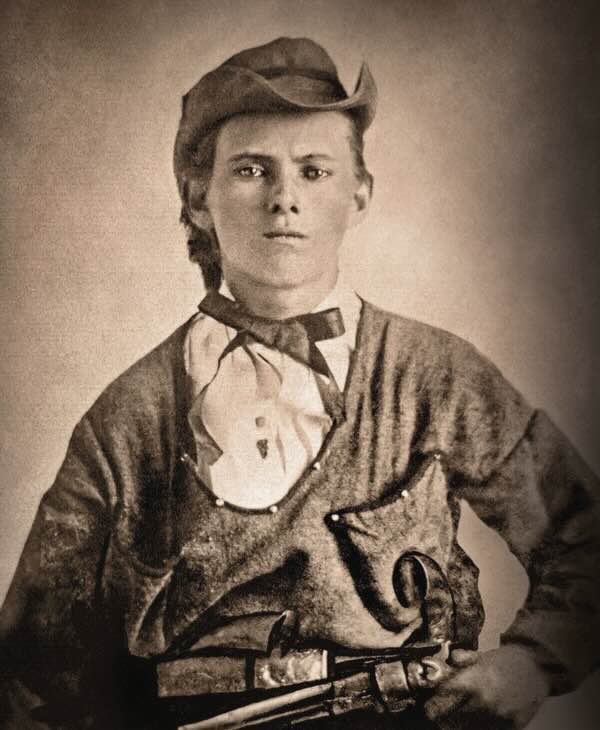
Jesse James led a notorious gang that engaged in several train and bank robberies in the 1800s across Missouri, Kentucky, Tennessee, Iowa, Kansas, and Minnesota.
Early Life
Jesse Woodson James (5th September 1847) was born in Clay County, Missouri, into a family of staunch supporters of the Southern cause.
His father, Robert Sallee James, a Baptist minister, died on a missionary trip to California when Jesse was 3 years old, leaving his mother, Zerelda Cole James, to raise their seven children alone.
When the Civil War erupted, Jesse and his older brother Frank enlisted in the Confederate guerilla groups, participating in violent raids to defend the ideal. But when the South lost the war, the brothers sharpened their vision into crime and saddle.
Criminal Empire
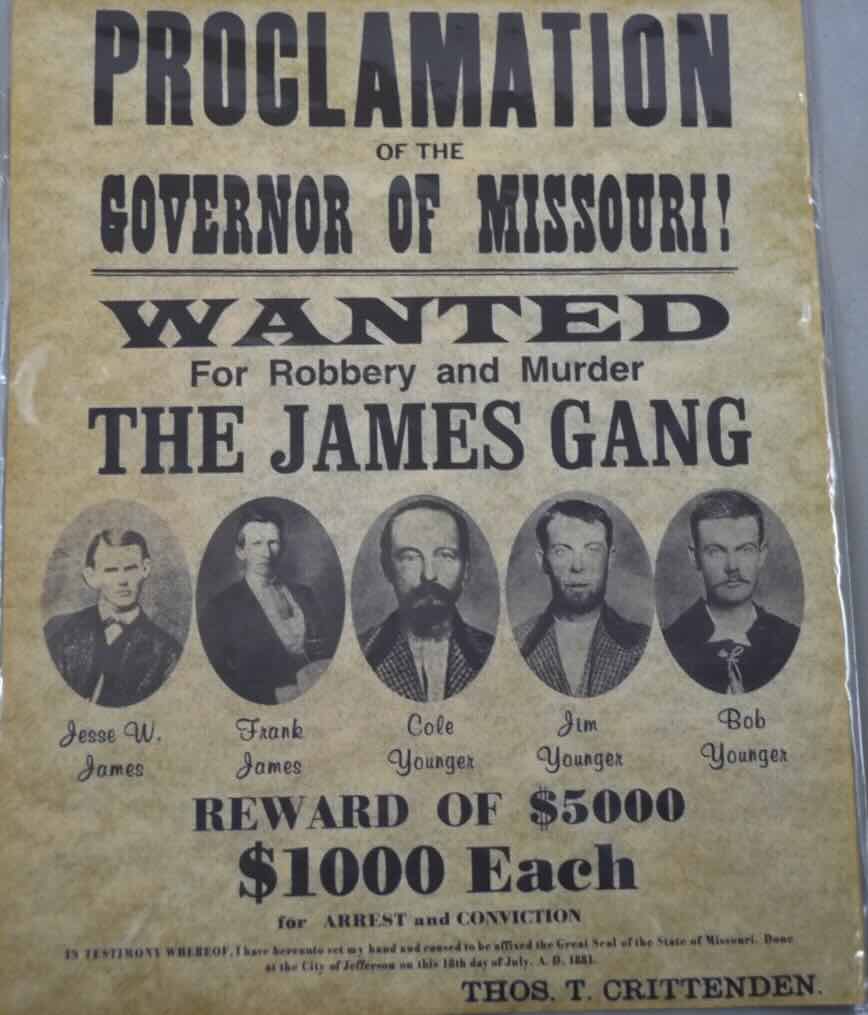
James knew he needed help for his criminal endeavours, so he joined forces with the Youngers’ gang, becoming the James-Younger Gang:
| No. | Name |
|---|---|
| 1 | Jesse James |
| 2 | Frank James |
| 3 | Cole Younger |
| 4 | Bob Younger |
| 5 | Jim Younger |
| 6 | John Younger |
| 7 | Clell Miller |
| 8 | Charlie Pitts |
| 9 | Bill Chadwell |
| 10 | Arthur McCoy |
| 11 | Dick Liddil |
| 12 | Robert Ford |
| 13 | Charley Ford |
| 14 | Ed Miller |
| 15 | Wood Hite |
| 16 | Clarence Hite |
Together, they committed many bank robberies, including:
| No. | Bank/Association | Location | Date |
|---|---|---|---|
| 1 | Clay County Savings Association | Liberty, Missouri | February 1866 |
| 2 | Daviess County Savings Association | Gallatin, Missouri | December 1869 |
| 3 | Bank of Columbia | Columbia, Kentucky | April 1872 |
| 4 | Ste. Genevieve Savings Association | Ste. Genevieve, Missouri | May 1873 |
| 5 | First National Bank | Northfield, Minnesota | September 1876 |
The James-Younger Gang also robbed trains, with at least six raided:
| No. | Railroad | Location | Date |
|---|---|---|---|
| 1 | Chicago, Rock Island, and Pacific Railroad | Adair, Iowa | July 1873 |
| 2 | Kansas Pacific Railroad | Muncie, Kansas | December 1874 |
| 3 | Missouri Pacific Railroad | Glendale, Missouri | October 1879 |
| 4 | Chicago and Alton Railroad | Glendale, Missouri | October 1879 |
| 5 | Chicago, Rock Island, and Pacific Railroad | Winston, Missouri | July 1881 |
But in these assaults, the band not only stole valuables; they took the lives of several people, innocent victims whose only fault was to be in the wrong place at the wrong time.
| No. | Name | Role/Title |
|---|---|---|
| 1 | William Westfall | Train Conductor |
| 2 | Joseph Whicher | Pinkerton Detective |
| 3 | John W. Sheets | Cashier |
| 4 | Captain John L. Banks | Captain |
| 5 | Major A.V. Johnson | Major |
| 6 | Frank McMillan | — |
Jesse James’s Death
Fame, money, freedom, and adrenaline were major drivers for an Old West legend. But the ultimate goal was to have a glorious death that could reverberate for centuries. But it doesn’t always come that way. Jesse James died not facing a dozen marshals, engaging in a gunfight, or shot while trying to escape from a moving train. He was betrayed and killed by a member of his own gang.
Missouri governor Thomas T. Crittenden placed a $10,000 reward on the capture or death of Jesse James. This bounty motivated Robert Ford and his brother to break their loyalty and find a route to impunity. The Ford brothers penned their names in an agreement with the authorities; they would kill James in exchange for a pardon and the recompense.
On the cool morning of the 3rd of April, 1882, coward Robert Ford shot Jesse James in the back of the head while he was hanging a picture on a wall.
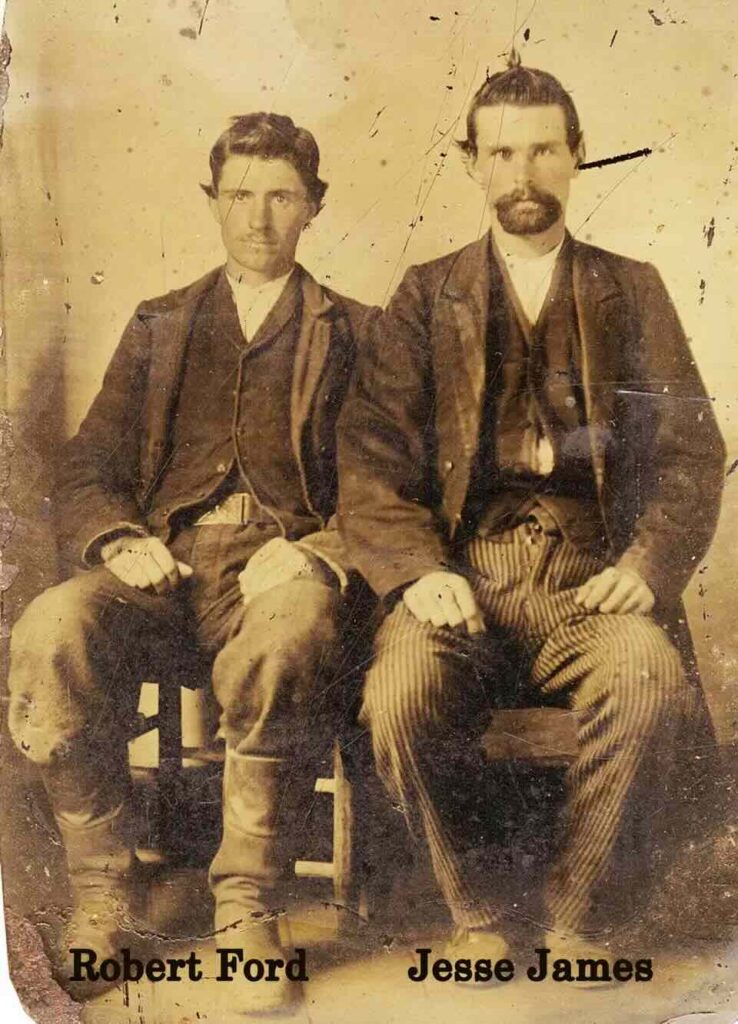
“I have never known a day of perfect peace.” Jesse James
Bonnie and Clyde: The Criminal Couple that Captivated America
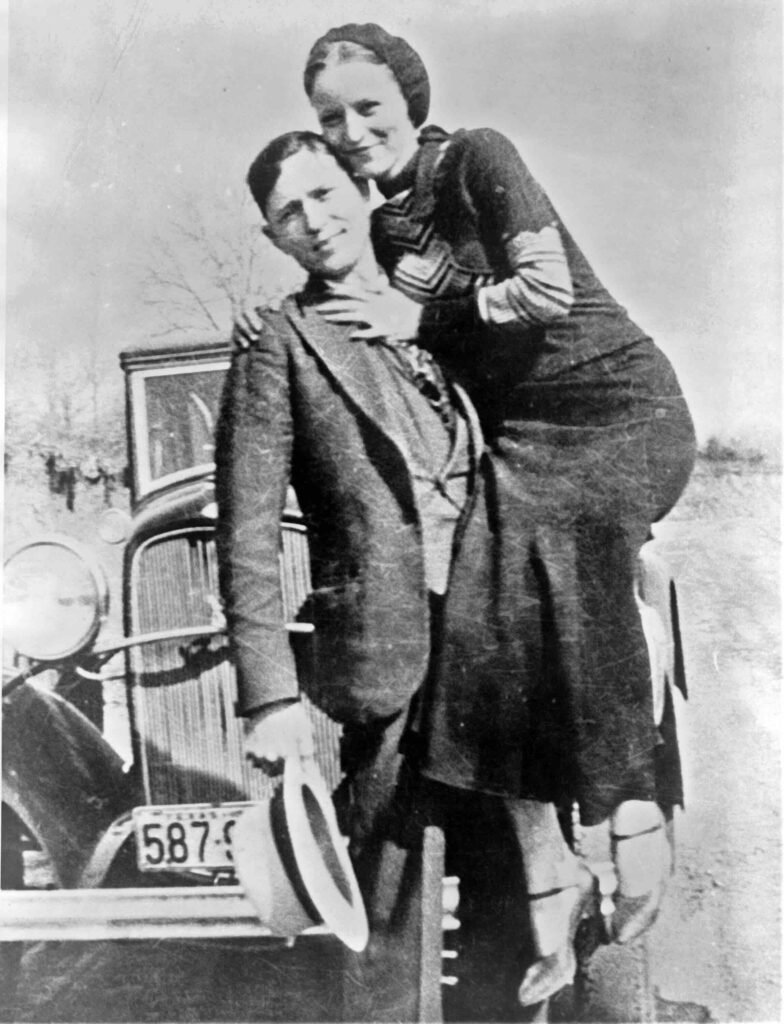
During the Great Depression, a passionate duo, teeming with adrenaline and gunfire, stole the spotlight from the Wall Street Crash and made countless headlines in newspapers: “Bonnie and Clyde.”
Who Were Bonnie and Clyde?
Partners in crime Bonnie Elizabeth Parker (born 1st October, 1910) and Clyde Chestnut Barrow (24th March, 1909) were a duet of danger who, in the 1930s, engaged in multiple bank thefts and shootouts with the police.
The media sensationalised their relationship and adventures, describing them as glamorous, colourful antiheroes, and setting the public’s mind alight.
Though their crime spree (from 1932 to 1934) was nothing but ghastly, they killed 13 people, including 9 police officers and four civilians.
“We ain’t heroes, Bonnie. We’re just survivors.”
How Did They Meet?
Bonnie and Clyde shared a mutual friend, Clarence Clay, from West Dallas, Texas. Bonnie lived in Clay’s house to help his sister Edith with a broken arm.
According to rumours, Bonnie (19) was in the kitchen making hot chocolate when Clyde (21) walked in. Their attraction was instant. But Bonnie was not free when she met Clyde. At 16, she married Roy Thornton, a high school classmate, who was imprisoned for robbery only three years after their marriage. Nevertheless, it was no barrier for the future crime lovers to unite.
Soon after meeting Bonnie, Clyde was arrested for burglary, but he escaped using a gun that Bonnie had smuggled into the jail. That action sealed the criminal alliance.
Always on the Run
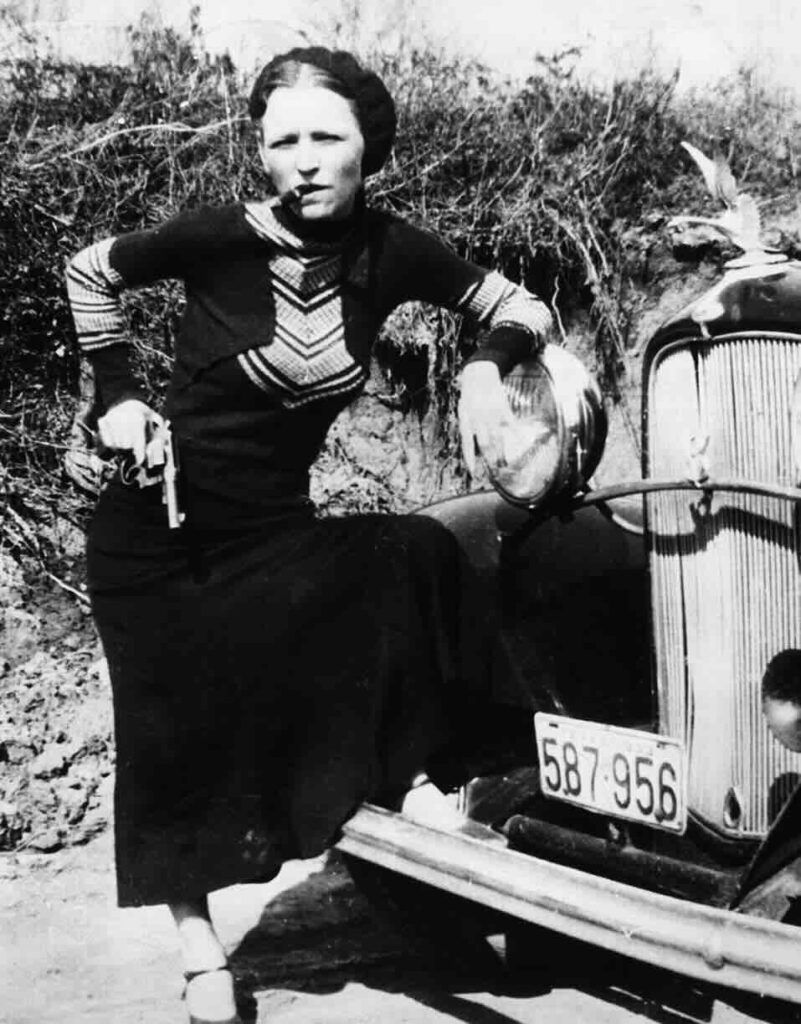
Over the next two years, the couple committed robberies and murders across various states.
Banks robbed by Bonnie and Clyde:
| No. | Bank | Location | Date |
|---|---|---|---|
| 1 | First National Bank | Lawrence, Texas | April 1932 |
| 2 | First State Bank | Rembrandt, Iowa | January 1934 |
| 3 | State Savings Bank | Knierim, Iowa | February 1934 |
| 4 | Local Bank | Everly, Iowa | May 1934 |
Apart from these, they likewise targeted small-town banks in Texas (Cedar Hill, Lancaster, Ponder, Celina, Lufkin, Grand Prairie, and Hillsboro), Oklahoma, New Mexico, and Missouri. Not only did financial institutions suffer the bitterness of the terrible couple; four civilians and nine police officers died during the duet crime spree.
Law enforcement agents killed by Bonnie and Clyde:
| No. | Name | Location | Date |
|---|---|---|---|
| 1 | Eugene C. Moore | Atoka County, Oklahoma | August 1932 |
| 2 | Malcolm Davis | Dallas, Texas | January 1933 |
| 3 | Harry McGinnis | Joplin, Missouri | April 1933 |
| 4 | J. W. Harryman | Joplin, Missouri | April 1933 |
| 5 | Henry D. Humphrey | Alma, Texas | June 1933 |
| 6 | Cal Campbell | Commerce, Oklahoma | April 1934 |
| 7 | William Calvil Campbell | Commerce, Oklahoma | April 1934 |
| 8 | Edward Bryan Wheeler | Grapevine, Texas | April 1934 |
| 9 | H.D. Murphy | Grapevine, Texas | April 1934 |
Civilians murdered by Bonnie and Clyde:
| No. | Name | Location | Date | Description |
|---|---|---|---|---|
| 1 | John Bucher | Hillsboro, Texas | April 1932 | Killed during a robbery at his store |
| 2 | Howard Hall | Atoka, Oklahoma | August 1932 | Killed during a robbery |
| 3 | Doyle Johnson | Temple, Texas | December 1932 | Killed in a car theft |
| 4 | W.D. Jones | Grapevine, Texas | April 1934 | Died in a shootout |
These horrible acts against law and order led to an intense manhunt; authorities vowed to end the whirlwind of horror of those two.
Even the Brightest Stars Fade
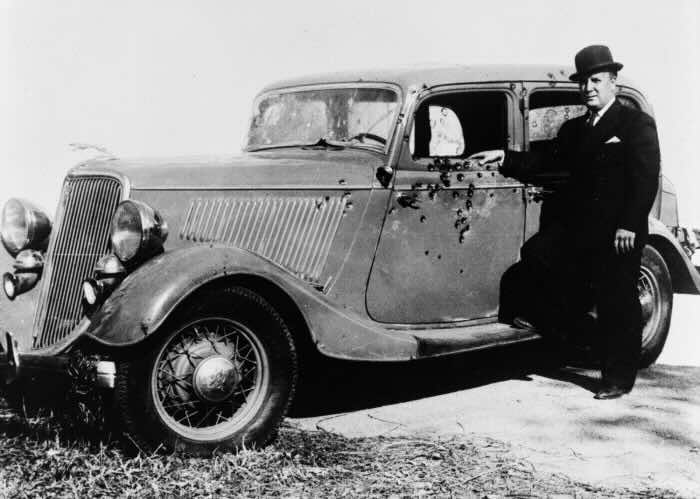
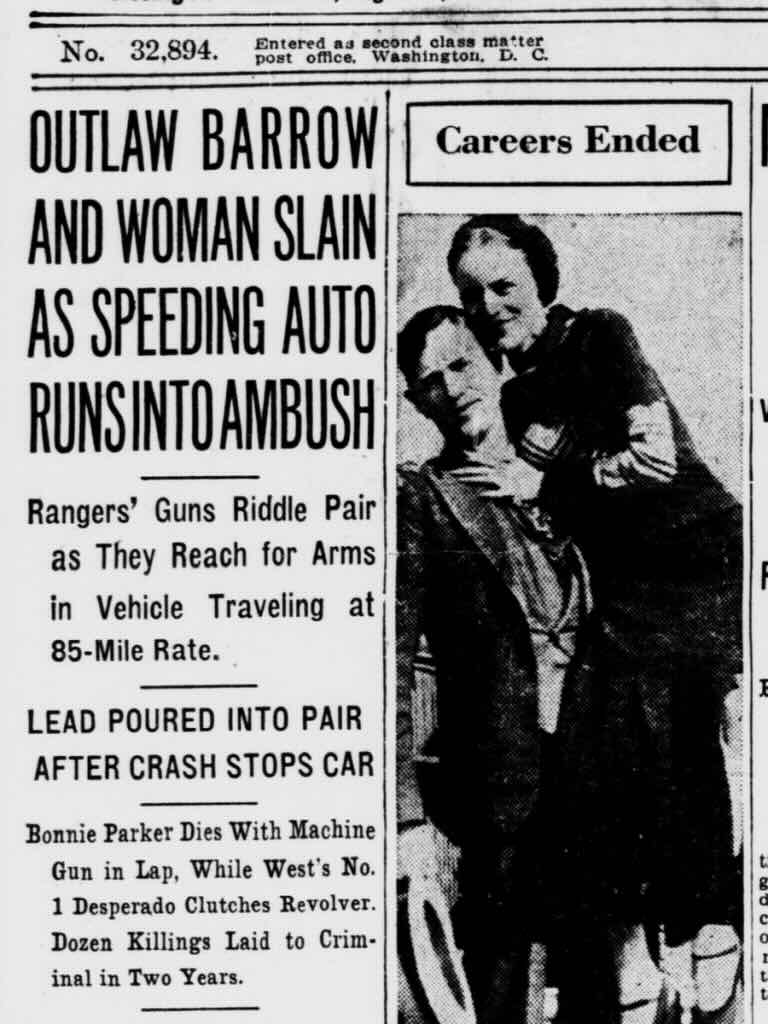
As the autumn leaves fall and wither, Bonnie and Clyde did as well. Law enforcement had been tracking them for months, and on 23rd May 1934, on a roadside near Saile, Louisiana, police ambushed the couple.
No sirens, no warnings, no negotiations.
A barrage of 150 rounds thundered, ending Bonnie and Clyde’s lives in an instant.
The Ford Model 730 Deluxe Sedan they were driving that day still shows the bullet holes at the Whiskey Pete’s Hotel and Casino in Primm, Nevada.
John Dillinger
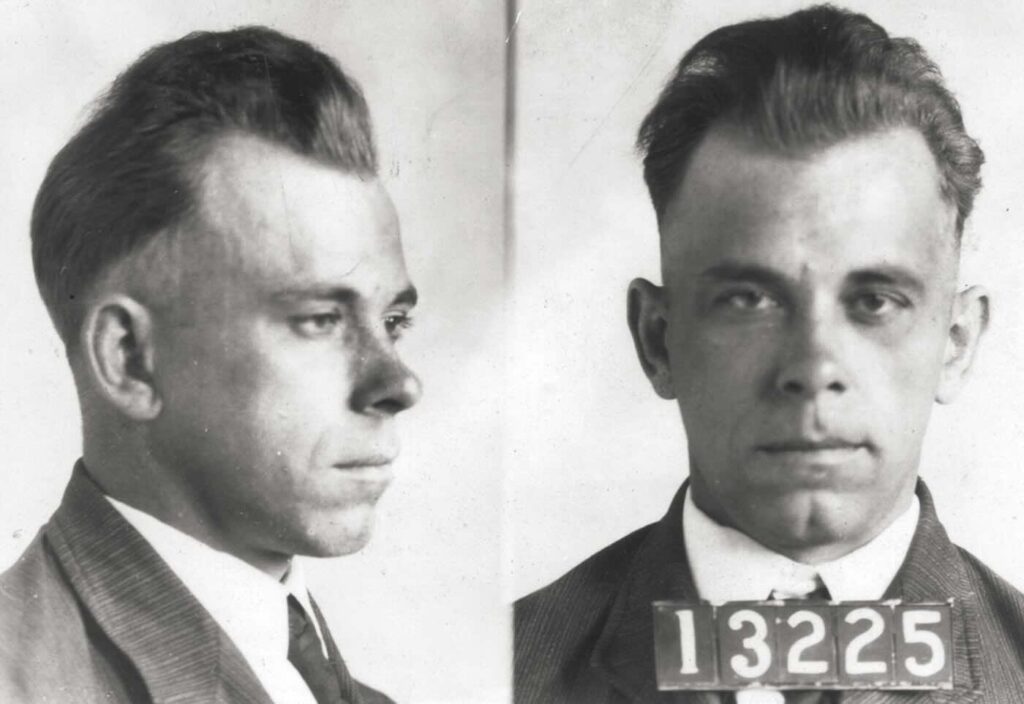
John Dillinger was an American Depression-era criminal, responsible for robbing four police stations and 13 banks in just a couple of years.
Dillinger’s Criminal Life
Indianapolis welcomed Dillinger on 22nd June, 1903, but further information about his childhood is scarce. As a teenager, he committed his first major robbery at Frank Morgan’s grocery store in Mooresville, Indiana, on 6th September 1924, which earned him almost a decade in jail.
Once out of the cage, in 1933, he formed a gang and committed a series of bank heists across the US Midwest with his accomplices:
| No. | Name |
|---|---|
| 1 | Harry Pierpont |
| 2 | Charles Makley |
| 3 | Russell Clark |
| 4 | John “Red” Hamilton |
| 5 | Homer Van Meter |
| 6 | Baby Face Nelson |
| 7 | Tommy Carroll |
| 8 | Eddie Green |
| 9 | Harry Copeland |
| 10 | Ed Shouse |
Banks in Ohio, Wisconsin, and South Dakota were whipped by this band of outlaws, but Indiana bore the brunt of six of the 13 robberies.
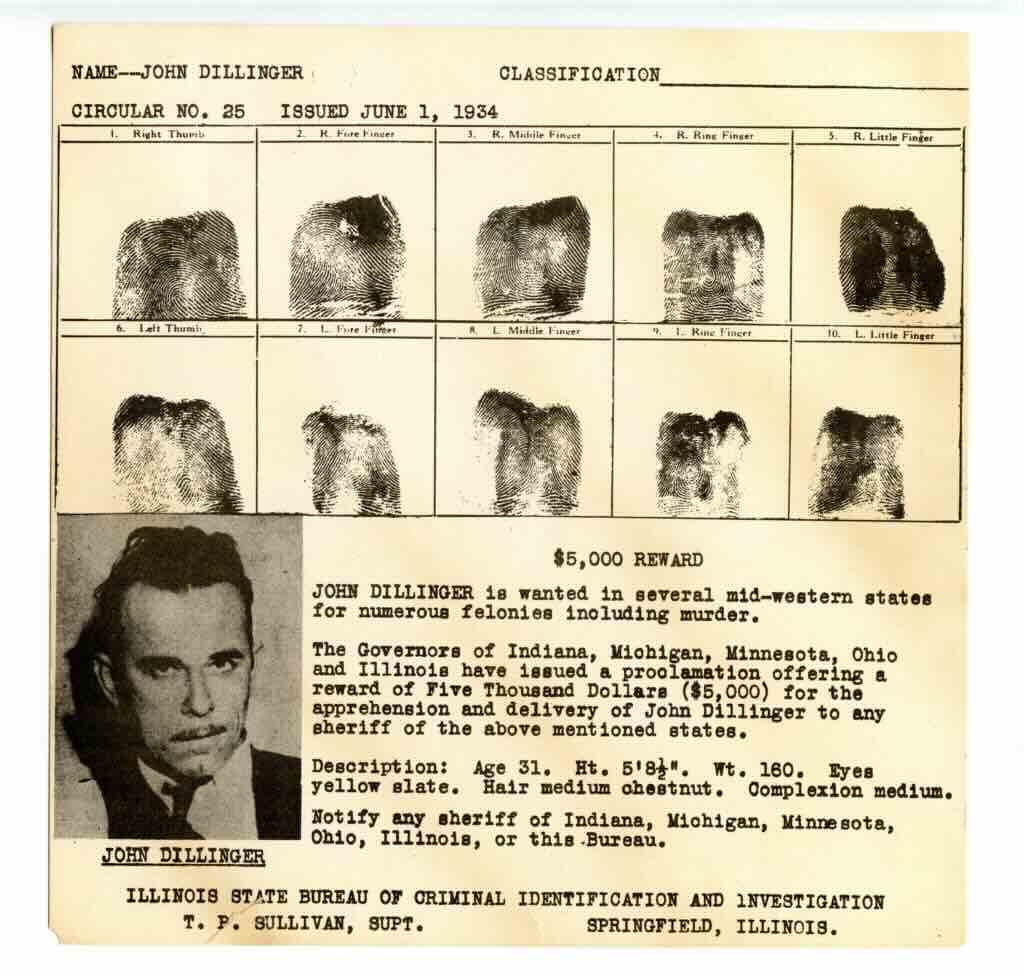
Here’s a list of the banks Dillinger’s gang robbed:
| No. | Bank | Location | Date |
|---|---|---|---|
| 1 | New Carlisle National Bank | New Carlisle, Ohio | 21 June, 1933 |
| 2 | Commercial Bank | Daleville, Indiana | 17 July, 1933 |
| 3 | Montpelier National Bank | Montpelier, Indiana | 4 August, 1933 |
| 4 | Bluffton Bank | Bluffton, Ohio | 14 August, 1933 |
| 5 | Massachusetts Avenue State Bank | Indianapolis, Indiana | 6 September, 1933 |
| 6 | Home Banking Company | Saint Marys, Ohio | 3 October, 1933 |
| 7 | Central National Bank | Greencastle, Indiana | 23 October, 1933 |
| 8 | American Bank and Trust Co. | Racine, Wisconsin | 20 November, 1933 |
| 9 | First National Bank | East Chicago, Indiana | 15 January, 1934 |
| 10 | Security National Bank and Trust Co. | Sioux Falls, South Dakota | 6 March, 1934 |
| 11 | First National Bank | Mason City, Iowa | 13 March, 1934 |
| 12 | First National Bank | Fostoria, Ohio | 3 May, 1934 |
| 13 | Merchants National Bank | South Bend, Indiana | 30 June, 1934 |
To continue with his symphony of lawlessness, the gang needed supplies. For that, they committed audacious heists and stole firearms, ammunition, and bulletproof vests from four police stations:
| No. | Location | Date |
|---|---|---|
| 1 | Auburn, Indiana | 14 October, 1933 |
| 2 | Peru, Indiana | 20 October, 1933 |
| 3 | Warsaw, Indiana | 20 December, 1933 |
| 4 | Crown Point, Indiana | 03 March, 1934 |
Escape from Prison
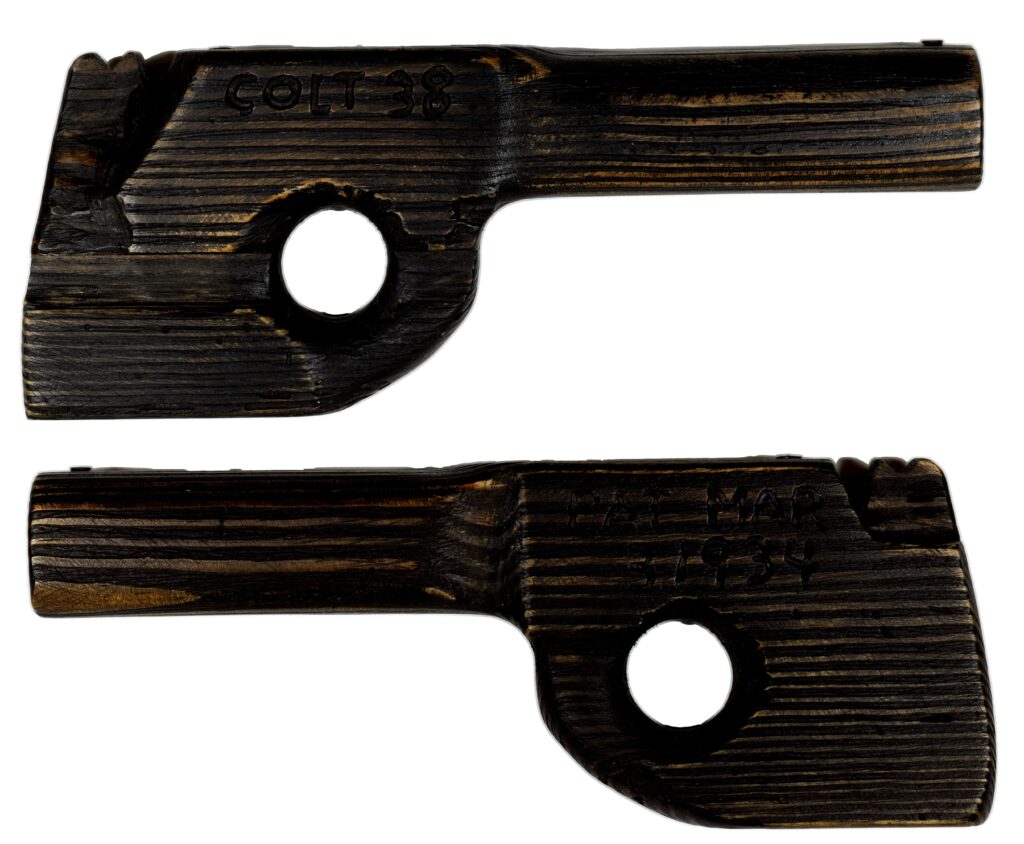
Dillinger’s jailbreaks and daring escapes made front-page news and fascinated readers. His master stroke was on 3rd March 1934, when he used a wooden gun to break free from the Crown Point jail in Indiana.
It is believed that Dillinger himself carved the fake weapon and painted it black with shoe polish. He overpowered the guards and locked them in cells, including Sheriff Lillian Holley’s deputy.
To flee, John Dillinger took Sheriff Holley’s own Ford V8, a move that got him into trouble with the FBI as he drove a stolen vehicle across state lines. He then became one of the FBI’s most wanted: Public Enemy No. 1.
“I don’t drink too much, and I smoke very little. I guess my only bad habit is robbing banks. Now you see, fellas, I ain’t such a bad guy at heart.”
The Sands of Time Ran Out
John Dillinger was hiding in the home of a Romanian woman, Anna Sage (Anna Capmǎnaş). Since she was facing deportation, she contacted the authorities and offered to reveal the gangster’s whereabouts in exchange for help with her immigration case and, of course, a reward.
On 22nd July, 1934, after watching the movie “Manhattan Melodrama” in the Biograph Theatre in Chicago, Dillinger realised he was being followed and tried to escape down a nearby alley. But FBI agents had already planned an ambush.
In a hail of gunfire, four slugs—face, heart, abdomen, back of the neck—ended John Dillinger’s life.
By the way, Anna Sage received a $5,000 reward for her assistance but was deported, regardless.
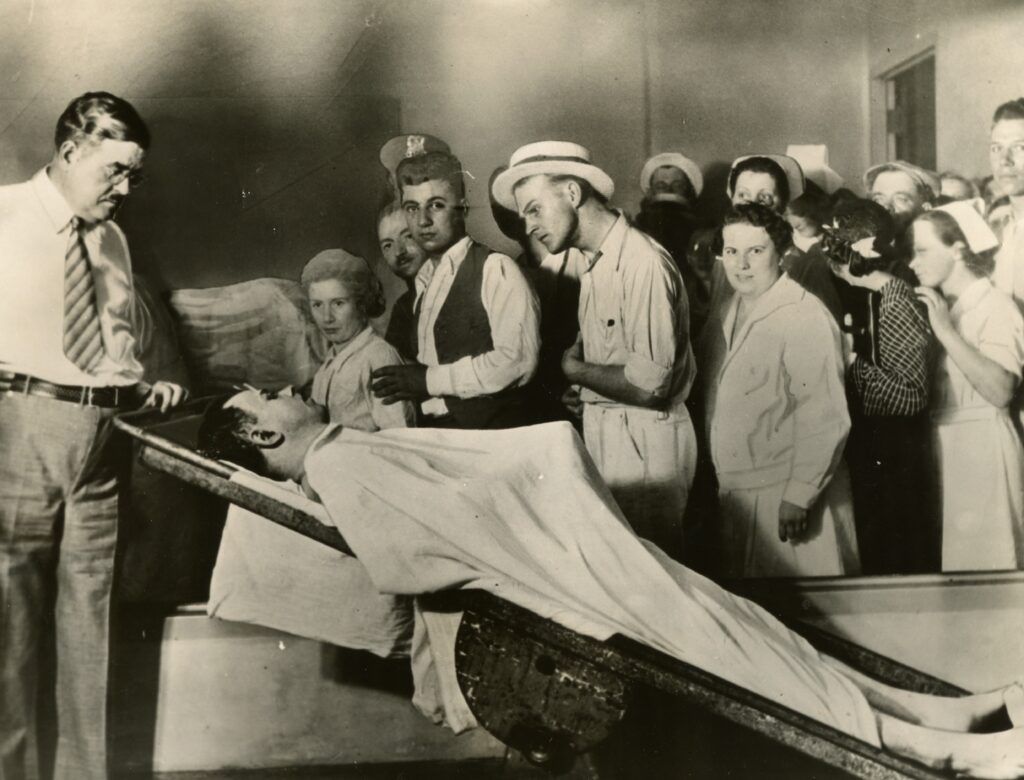
“You can get more with a simple prayer and a Thompson submachine gun than you can with a simple prayer alone.”
Ronnie Biggs and the Great Train Robbery of 1963
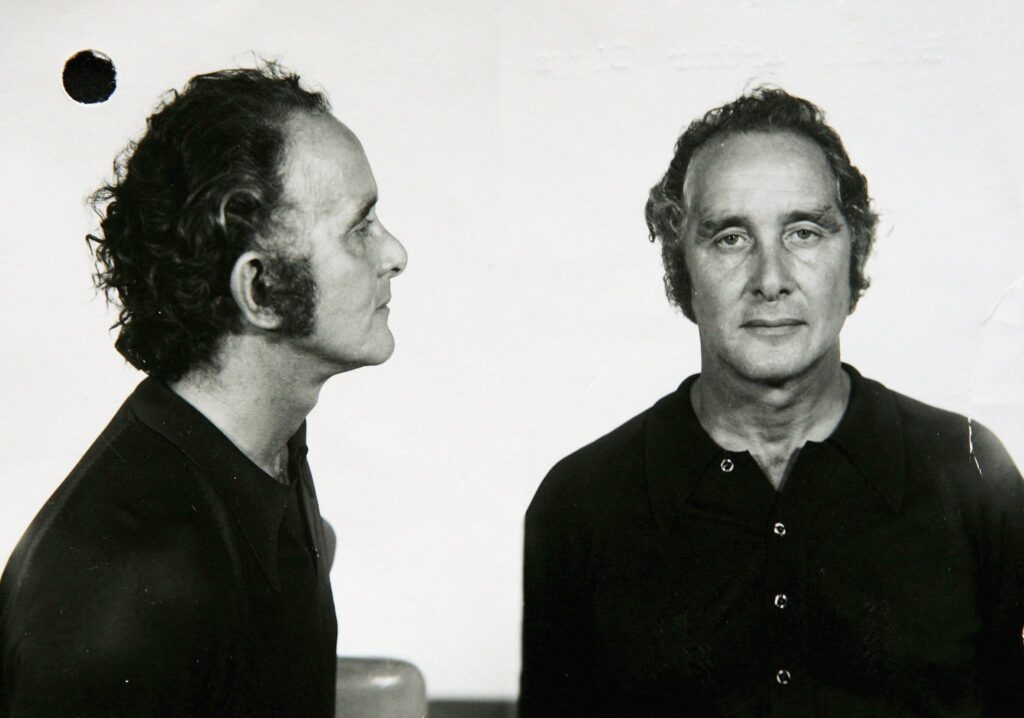
Ronnie Biggs, a notorious UK criminal, was part of the gang that carried out the Great Train Robbery in 1963, escaping with a bounty of £2.6 million from a Royal Mail train travelling from Glasgow to London.
Early Life
Born in Stockwell, London, on 8th August 1929, Ronald Arthur Biggs suffered the hardships of growing up during WWII.
Because of the Luftwaffe bombings, Biggs was evacuated from London to Flitwick, Bedfordshire, and later to Delabole, Cornwall.
His father, a bus driver, was a strict disciplinarian who wanted to keep everything under control. But it didn’t stop Ronnie from engaging in low-level pilfering to supplement his meagre diet during the war.
Life After WWII
Throughout the 1940s, Ronnie Biggs had been involved in minor criminal activities, but in 1950, he was sentenced for car theft. In jail, he met Bruce Reynolds, the mastermind behind the Great Train Robbery.
By the early 1960s, Biggs was clean and established a small building firm in Redhill.
Yet crime is a powerful magnet that doesn’t let go that easily. Bruce Reynolds persuaded and convinced Biggs to join his band to execute one of the biggest train heists in history.
The Great Train Robbery
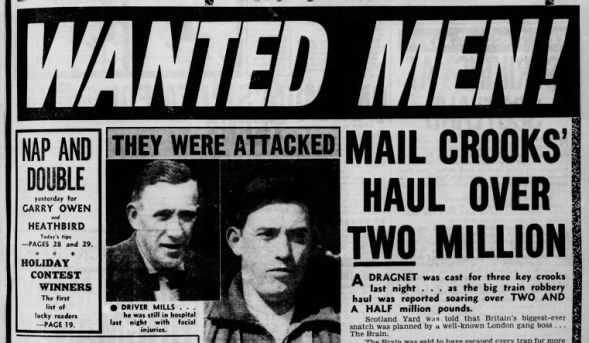
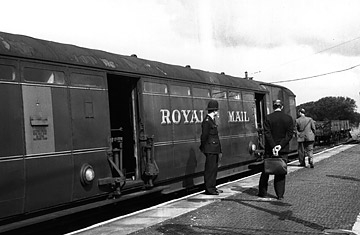
On 8th August 1963, on his 34th birthday, Ronnie Biggs and 14 others intercepted the Glasgow-London Royal Mail Train at Bridego Railway Bridge, near Ledburn in Buckinghamshire.
The gang had planned the famous heist for months, using inside information from a Royal Mail employee known as “The Ulsterman” (never caught).
Knowing how to stop the train, they tampered with the railway signals, switching a green light to red with a battery-powered device. At 3 am, the train was brought to a halt; the robbers entered and overpowered the driver, Jack Mills, who was struck on the head with a metal bar, causing serious injuries.
The gang seized 120 mailbags containing £2.6 million (equivalent to £69 million today). They transported the loot to Leatherslade Farm for division.
However, they’d left fingerprints on a Monopoly board used during their leisure time.
In a flash, the police tracked down the hideout, and just three weeks later, on 4th September, Biggs was arrested in South London, along with 11 others. This led to the conviction of most of the bandits, with eleven sentenced to up to 30 years behind bars.
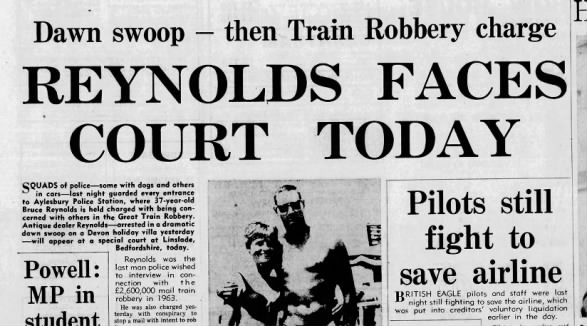
Here’s the list of the members of the gang, their sentences, and fates:
| No. | Name | Sentence | Time Served | Status |
|---|---|---|---|---|
| 1 | Bruce Reynolds | 25 years | Released in 1978 | Deceased (died in 2013) |
| 2 | Ronnie Biggs | 30 years | Escaped in 1965, recaptured 2001, released 2009 | Deceased (died in 2013) |
| 3 | Buster Edwards | 15 years | Released in 1975 | Deceased (died in 1994) |
| 4 | Charlie Wilson | 30 years | Escaped 1964, recaptured 1968, released 1978 | Deceased (murdered in 1990) |
| 5 | Gordon Goody | 30 years | Released in 1975 | Deceased (died in 2016) |
| 6 | Roy James | 30 years | Released in 1975 | Deceased (died in 1997) |
| 7 | John Daly | Acquitted (lack of evidence) | — | Deceased (died in 1988) |
| 8 | Brian Field | 25 years (reduced to 5 on appeal) | Released in 1967 | Deceased (died in 1979) |
| 9 | Leonard Field | 25 years | Released in 1967 | Deceased (died in 1970) |
| 10 | John Wheater | 3 years | Released in 1966 | Deceased (died in 1985) |
| 11 | Tommy Wisbey | 30 years | Released in 1976 | Deceased (died in 2016) |
| 12 | Jim Hussey | 30 years | Released in 1975 | Deceased (died in 2012) |
| 13 | Roger Cordrey | 20 years | Released in 1971 | Deceased (died in 1988) |
| 14 | Bob Welch | 30 years | Released in 1976 | Deceased (died in 2019) |
| 15 | William Boal | 24 years | Died in prison (1970) | Deceased |
Life as a Celebrity
In 1965, Biggs escaped from Wandsworth Prison using a rope ladder and evaded authorities by undergoing plastic surgery and fleeing to Australia and later to Brazil.
For 36 years, he lived as a fugitive. During his time at large, he became a media sensation, often giving interviews and making public appearances, even recording the song “No One Is Innocent” with the punk band the Sex Pistols in 1978.
Return to Homeland
In 2001, Biggs returned to the UK, citing declining health, where he was re-arrested and imprisoned. But in 2009, he was released on compassionate grounds.
On 18th December 2013, at 84, Ronnie Biggs passed away in the Carlton Court Care Home in East Barnet, North London.
What Happened to the Money?
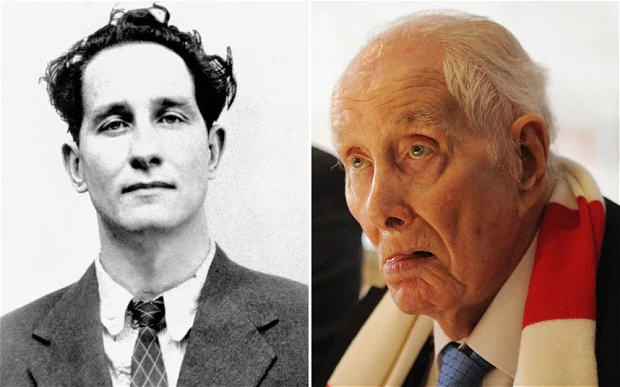
Despite the significant efforts of law enforcement, most of the stolen money was never recovered.
Some of the cash was retrieved during the police investigation; for instance, a portion was found at Leatherslade Farm, the gang’s hideout, but the bulk remains unaccounted for. Perhaps the robbers either spent their share quickly or hid it very well.
Over the years, small amounts were discovered, but these were minimal compared to the total amount stolen.
Carl Gugasian: America’s Most Prolific Bank Robber
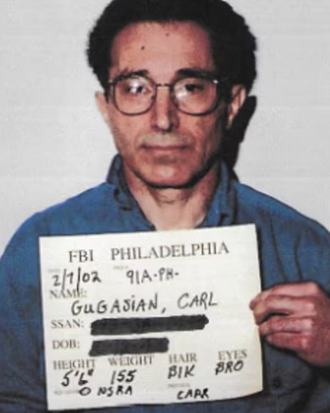
Known as “The Friday Night Bank Robber,” Carl Gugasian is an American serial bank robber with a record of at least 50 robberies over a 30-year period, primarily during the 1970s and 1980s.
Early Years and Young Adulthood
Carl Gugasian took his first breath in Pennsylvania on 12th October 1947 in a stable Armenian family environment with no reports of significant traumas or hardships during his upbringing.
At 15, Carl was shot while robbing a candy store and sent to a state youth facility for 18 months.
After leaving prison, he continued high school, graduated, and studied for a bachelor’s degree in electrical engineering at Villanova University. In 1971, he enrolled in the US Army and received tactical weapons and special forces training, valuable skills that he would later use during his bank robberies.
After the military service, he got a master’s degree in systems analysis and doctoral work in statistics and probability.
Private and Professional Life
Carl Gugasian lived by a strict code of conduct. He was often seen in his neighbourhood running with a weighted backpack to build strength and endurance, in addition to practising yoga, meditation, and health foods. He also loved travelling, and this passion took him to places such as Paris, Africa, and Armenia, amongst many others.
Regarding his economic activities, he was registered at the tax office as a self-employed statistical consultant and a professional gambler, which justified around half a million dollars in his bank account. As an introvert, Gugasian kept his illegal enterprises separate from his personal life, living a dual existence for decades: one of an ordinary individual and another of a meticulous bank robber.
Despite having stolen large sums of money, Carl did not live a lavish lifestyle and refrained from splurging, keeping him undetected.
Criminal Career
Gugasian planned his heists over long periods of time, focusing on potential targets, security procedures, police response times, and even the habits of local residents.
To gather intel, he would visit banks, disguising himself as a customer with fake moustaches or glasses.
Modus Operandi
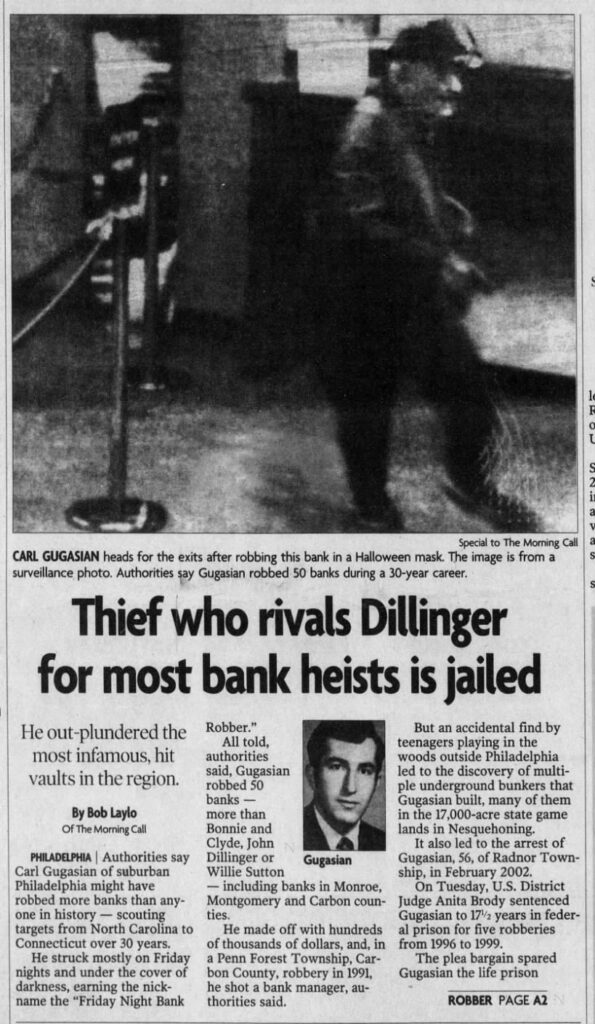
Carl Gugasian’s robberies followed a precise and repeatable pattern.
His crimes typically occurred between October and April, taking advantage of the early nightfall. He targeted banks near woods to ensure a reliable escape route and preferred Friday nights, striking 10 minutes before closing time to minimise the number of customers while maximising the cash available.
Armed with a handgun, he would enter the bank dressed in baggy clothes to conceal his build. His face was hidden behind a tight-fitting mask, often a Freddy Krueger disguise, which obscured his skin colour and identity.
From the moment he entered, his actions were swift and calculated.
Gugasian would leap onto the counter, rifle through the cash drawers, and be out in less than two minutes.
Upon securing the cash, he bolted into the woods, deployed a scent blocker, jumped on a dirt bike, and rode through dense trees to a van parked near a freeway. After loading the bike into the vehicle, he’d drive away, leaving no trace behind.
As per the FBI, a professional was responsible for the crimes. They calculated his height and age based on scene analysis and concluded he was physically fit, agile, and perhaps with a military background, given his skilfully hopping over bank counters. But with no clue about the identity of the thief.
“I’ve never seen anything like this before in all my years with the FBI. He is truly a master of his craft.” FBI Profile Unit Agent.
Carl Gugasian Bank Robberies
Gugasian often targeted different branches of the same bank within a region. For instance, he robbed several offices of “First Valley Bank” and “Merchants Bank” in Pennsylvania.
Based on court documents and police information, here is a list of banks that were suspected or confirmed to be raided by “The Friday Night Bank Robber”:
| No. | Bank | State |
|---|---|---|
| 1 | First Valley Bank | Pennsylvania |
| 2 | Merchants Bank | Pennsylvania |
| 3 | Industrial Valley Bank | Pennsylvania |
| 4 | First National Bank of Allentown | Pennsylvania |
| 5 | Penn Savings Bank | Pennsylvania |
| 6 | Summit Bank | New Jersey |
| 7 | First Fidelity Bank | New Jersey |
| 8 | National Westminster Bank | New Jersey |
| 9 | Midlantic National Bank | New Jersey |
| 10 | Key Bank | New York |
| 11 | Marine Midland Bank | New York |
| 12 | Chase Manhattan Bank | New York |
| 13 | Nortstar Bank | New York |
| 14 | Farmers Bank | Delaware |
| 15 | Maryland National Bank | Maryland |
| 16 | Mechanics Bank | Massachusetts |
| 17 | Connecticut National Bank | Connecticut |
| 18 | Dominion Bank | Virginia |
The Clues that Led to Gugasian’s Arrest
For over 30 years, Gugasian had been invisible to authorities, but his luck ended in an innocent manner.
In 2001, two teenagers playing in the woods in Radnor, Pennsylvania, discovered a three-foot sealed PVC pipe hidden inside a concrete drain. Curiosity lured the boys to open the pipe, only to discover documents related to numerous bank robberies and instructions on how to clean a Beretta firearm. They took the pipe to the police.
An officer went back to the site and uncovered a bunker—one of 18 Gugasian had in the Northeast—containing more PVC pipes and waterproof containers with books, maps, notes on 160 banks from Virginia to Connecticut, five guns, 500 rounds of ammunition, and eight Halloween masks. Local authorities contacted the FBI, which at once knew those things belonged to the man who had been robbing banks for decades.
Also in the bunker, federal agents found martial arts leaflets from a karate school nearby. Agents went to the school and asked the owner about any middle-aged fit students. The administrator said he had a 55-year-old third-degree black belt named Carl Gugasian.
Now the investigation was focused on a name, not a ghost.
Arrest, Sentence, and FBI Collaborator
On 7th February 2002, Carl Gugasian was arrested at the Philadelphia Free Library, where he was researching and photocopying topographical maps.
At the beginning of the cross-examination, he’d remained tight-lipped, but when the FBI brought in Gugasian’s 79-year-old mother, two brothers, and girlfriend, he changed his mind and confessed. His family was in shock; they had no inkling about his secret business.
When agents asked Gugasian why he chose to become a bank robber, he said that when he was confined to a youth detention centre for robbing a candy store at 15, he thought that his juvenile records would never be expunged. His only choice was a life of crime. In summary, Carl Gugasian, one of the most elusive criminals in history, robbed around 50 banks, stole $2 million, and shot two people by accident—both survived.
Gugasian was facing a potential 155-year sentence, but since he was so helpful to investigators and in court seemed genuinely contrite, the judge sentenced him to only 17 years.
“The most prolific bank robber this nation has ever known.” Linwood Wright Jr., Federal Prosecutor.
Three of the many bank workers Gugasian terrorised during his criminal career were present at this sentencing. One of them, Dawn Bressles, said, “Carl, the last time we met, you were hiding behind a mask and pointing a gun at me. How nice it is to meet you, Freddy Krueger, today under these circumstances. I hope you enjoy the next 17 years in prison. I hope you have nightmares, just like I do.”
Ashamed, Gugasian stared at the floor. In a brief note, he expressed his regret for the suffering he had caused to his victims.
“While I always rationalised my conduct by believing that robbing banks had no victims, I have come to realise that everyone who was forced to endure the harrowing experience of a robbery suffered tremendous harm, even though they were not physically injured.”
Part of the deal to reduce Gugasian’s sentence was to become an incarcerated consultant to the FBI and record training videos on fighting bank robberies for police academies. After 15 years in confinement, Carl Gugasian was released on 5th May 2017 at 69 for good behaviour.
D.B. Cooper: The Mystery Behind America’s Greatest Sky Heist
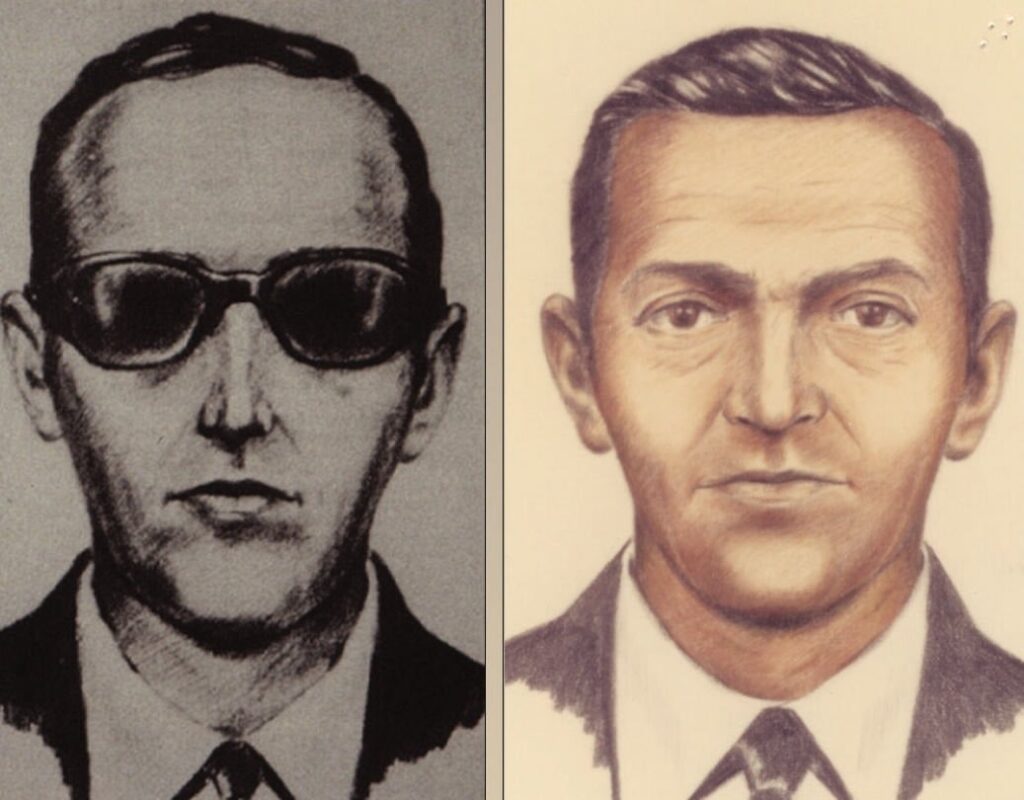
D.B. Cooper was the alias of an unidentified man who hijacked a Boeing 727 on 24th November 1971, extorted $200,000 in ransom, parachuted out of the plane, and disappeared without a trace.
The Hijacking
Cooper was just another passenger boarding the Northwest Orient Airlines Flight 305 from Portland, Oregon, to Seattle, Washington.
But shortly after taking off, he handed a written note to air hostess Florence Schaffner, who initially thought it was a joke and put it in her pocket without reading it. Cooper leaned in and told her, “Miss, you better look at that note. I have a bomb.”
The hijacker opened his briefcase and showed her what appeared to be an explosive device with wires, red sticks, and a battery. Then, he verbally outlined his terms: $200,000 in unmarked $20 bills ($1.5 million today), four parachutes, and a fuel truck standing by in Seattle to refuel the plane.
Alarmed, authorities conceded to the hijacker’s demands. Upon landing, he released the 35 passengers, part of the crew members, and refuelled the aeroplane to take off again, heading towards Mexico City. The remaining crew complied with Cooper’s specific requests, including speed and flap angles.
Disappearance into Thin Air
Somewhere between Seattle and Reno, Cooper opened the side door at 8:13 pm and jumped out of the aircraft with the ransom money and a parachute, disappearing in the dark skies. The FBI launched an extensive manhunt, but despite the bureau’s efforts, no trace of the criminal or the money was ever found.
Speculations
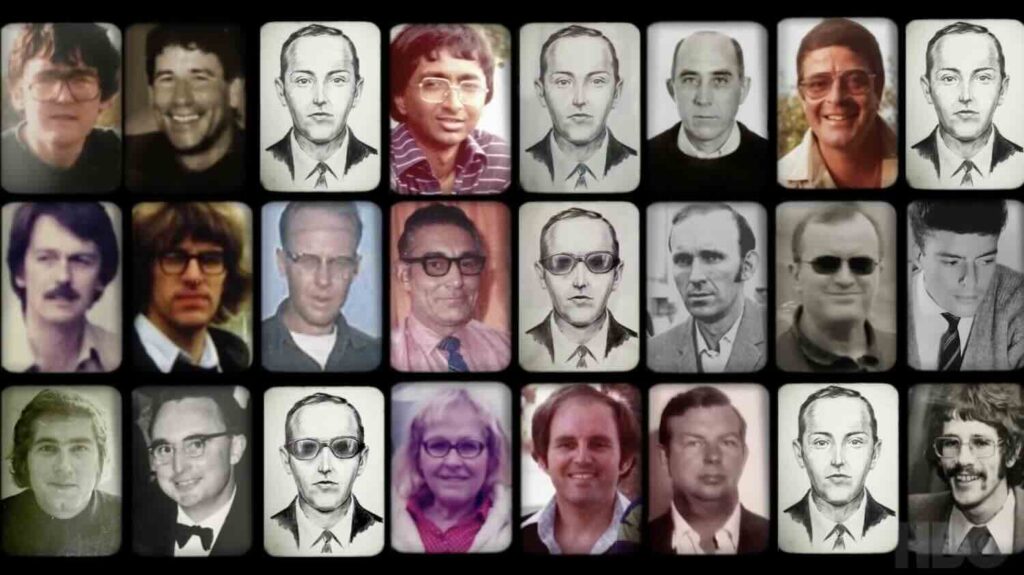
Several intriguing theories surrounding D.B. Cooper’s escape and whereabouts have flourished throughout the years.
Survived and Lived Quietly
After landing, he used the ransom money to start anew under a new identity by blending into society.
Died During the Jump
Some believe his life ended during his daring leap, and his body was never recovered.
Duane Weber
Jo Weber, the widow of Duane Weber, affirmed that her husband confessed to being D.B. Cooper on his deathbed. Despite circumstantial evidence, the FBI could not link him to the hijacking.
Richard Floyd McCoy
He was arrested for a similar hijacking a few months after Cooper’s. At first investigators believed he was indeed the hijacker, but he was much younger—27 years old at the time—and didn’t match the overall physical description.
After the skyjacking, the police apprehended McCoy, and he was sentenced to 45 years, but he broke out of a maximum-security prison and evaded capture for three months until he was shot by officers in Virginia in 1974.
Kenneth Christiansen
Amateur sleuths pointed at this former paratrooper and Northwest Airlines employee; he matched the physical description and had a background that could explain the hijacking’s execution.
Lynn Doyle Cooper
Marla Cooper claimed that her uncle was the hijacker based on family conversations. But the evidence was not enough.
Robert Rackstraw
He was considered a suspect because of his criminal history, skills, and military experience as a Vietnam War veteran.
New Evidence Suggests Richard Floyd McCoy was D.B. Cooper (November 2024)
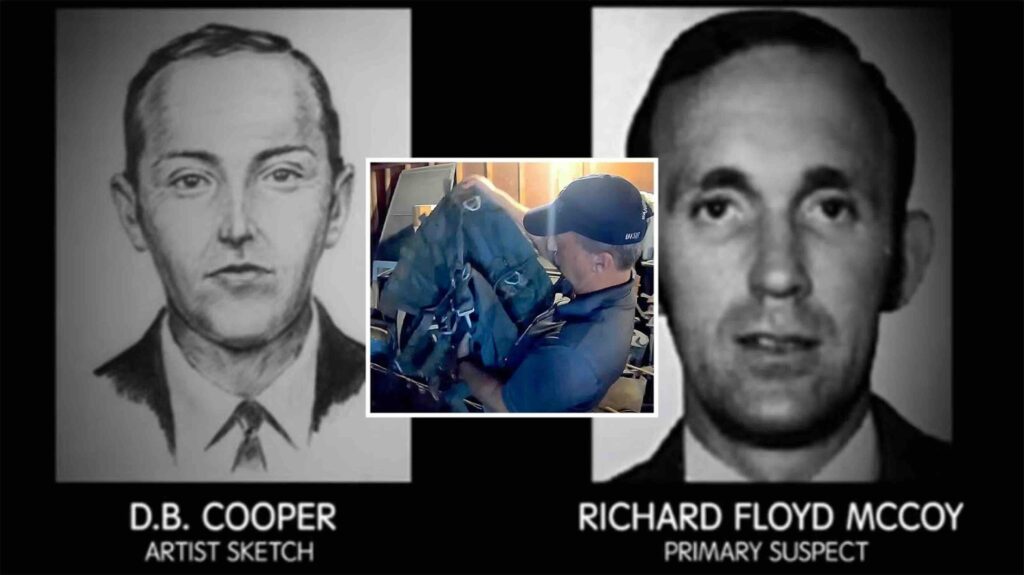
Chanté and Rick, Richard McCoy’s children, believe that their dear old dad may have been the notorious central figure in the 1971’s unsolved hijacking. They claim to have proof.
For years, both siblings held their suspicion out of consideration for their mother, Karen, who they also believed was complicit in the crimes. But since both their parents are now deceased, they decided to open the doors for investigations.
The evidence is a modified parachute that was tucked away in a storage shed on a family property in North Carolina, as well as a harness and a skydiving logbook that Chanté claims to show D.B. Cooper’s movements near Oregon and Utah.
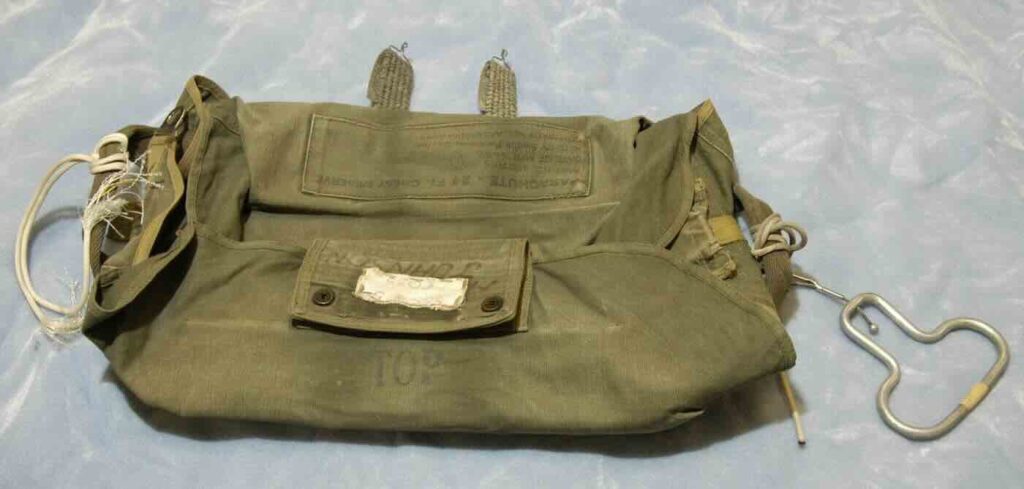

The FBI searched the estate for several hours with over a dozen agents and got hold of the unique parachute. Could it offer new insights into the 50-plus-year-old case?
Well, I hope you’ve enjoyed this post about legendary outlaws and crime stories. If you want us to research and write about any other topic, feel free to ask and comment in our section below.


